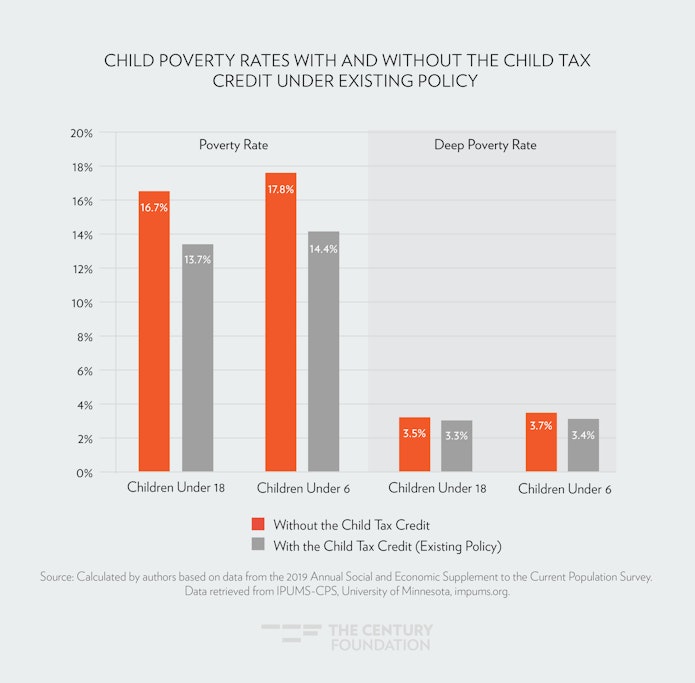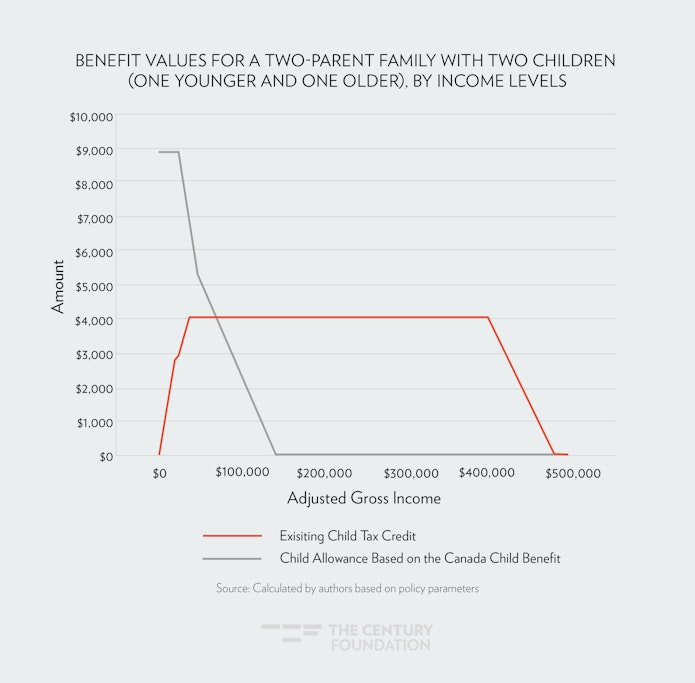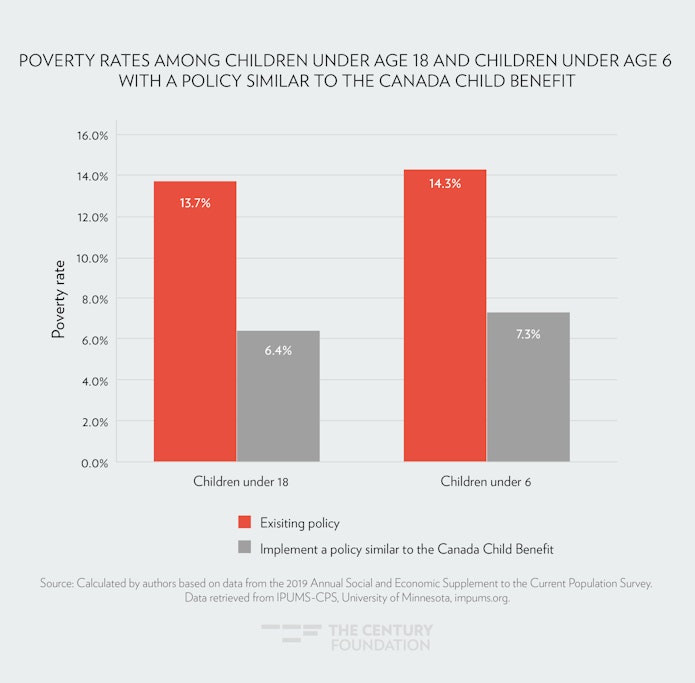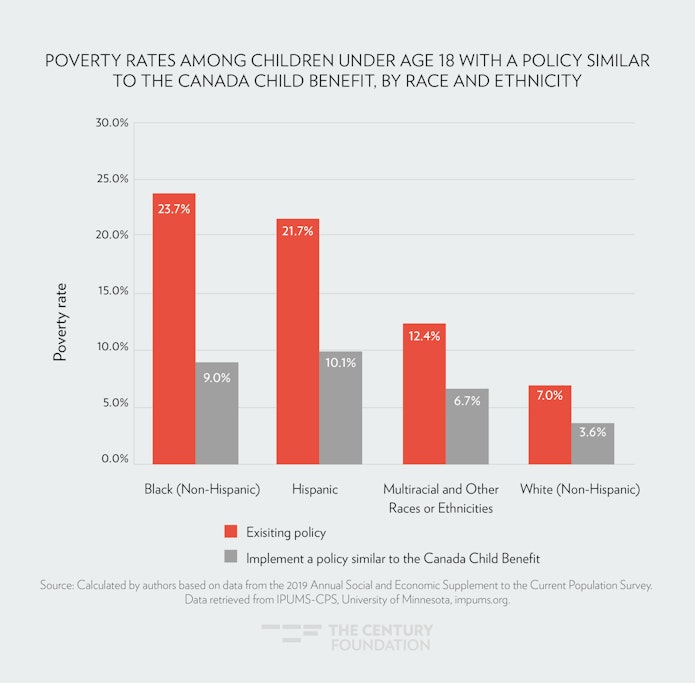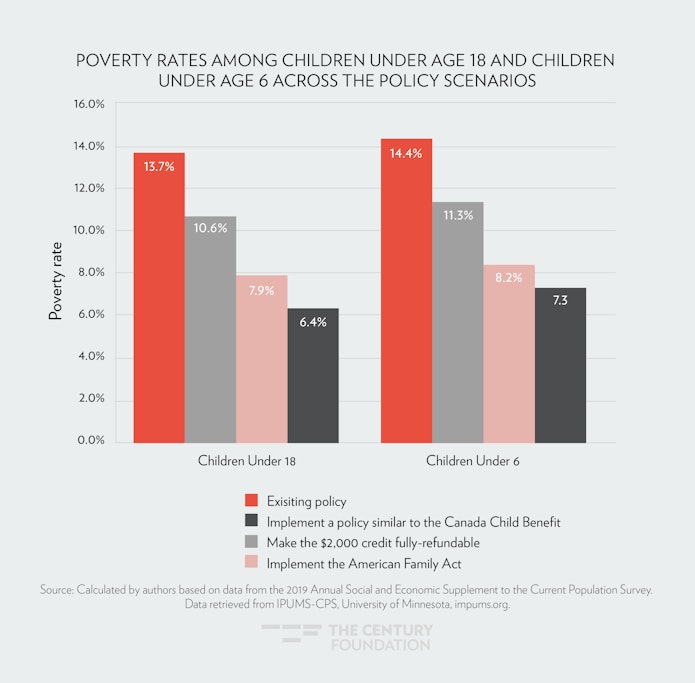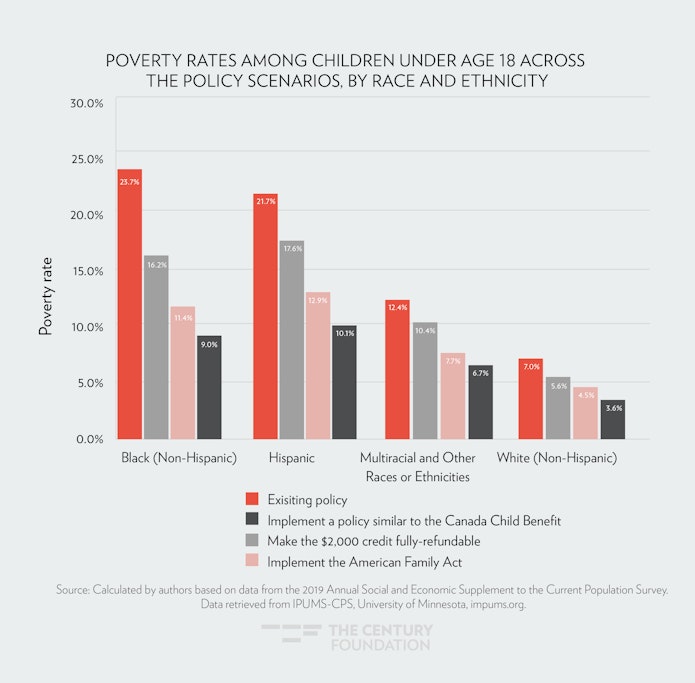The child poverty rate is higher in the United States than in any other wealthy nation, and the COVID-19 pandemic has further exacerbated this crisis. Among OECD Nations, the only countries with a higher incidence of child poverty are Chile, Israel, and Turkey.1 Pre-pandemic, at a time of “record-low unemployment,” one-in-seven U.S. children (more than 10 million) lived in poverty,2 and 12.5 million children were food insecure and without consistent access to enough food “for an active, healthy life.”3
The crisis of child poverty in the United States directly threatens the personal development of millions of children and further compromises the economic health of the country. The recent report on reducing child poverty from the National Academy of Sciences (NAS) concludes that “the weight of the causal evidence indicates that poverty itself causes negative child outcomes, especially when it begins in early childhood or persists throughout a large share of a child’s life.”4 The report also finds that child poverty costs the nation between $800 billion and $1.1 trillion per year5 in terms of productivity, public safety and incarceration, health care expenditures, homelessness, and child maltreatment.6
The main reason that the child poverty rate is higher in the United States than other wealthy nations is that other nations have much more robust social policies for children. Almost all wealthy nations other than the United States provide some form of child allowance to help with the costs of raising children. Child allowances are part of these countries’ network of social policies, and many of these policies are highly effective at keeping children out of poverty.7 A notable example is the Canada Child Benefit, which was implemented as one of a number of policies designed to halve the poverty rate in Canada by 2030. The benefit is greatest for low-income families, who receive an allowance of roughly $4,000 per child, per year (and roughly $4,800 for the youngest children). The benefit phases out with income, so higher-income households receive only a partial benefit, and the highest income families are ineligible. While the Canada Child Benefit has only been in place for a short time, it has already been associated with significant reductions in the poverty rate, which fell by 20 percent between 2015 and 2017.8
In the United States, the closest policy that we have to a child allowance is a Child Tax Credit of $2,000 per year, per qualifying child. Totaling over $120 billion per year, the Child Tax Credit is the largest federal expenditure on children, but unlike child allowances in other countries, it is not structured to reach children who need it most. Fully one-third of children do not receive the full credit because their families do not earn enough to qualify.9 Reforming the Child Tax Credit to create a child allowance was one of the key proposals put forward in the National Academy of Sciences report on cutting child poverty in the United States by half,10 and a variety of bills have already been introduced in the U.S. Congress that would enact such a reform. The proposal with the largest predicted impact on the poverty rate (and the widest support across both chambers) is the American Family Act (AFA), which would raise the value of the Child Tax Credit to $3,600 per year for young children and $3,000 for older children, make the credit fully refundable, and distribute it monthly—thus establishing a child allowance. A one-year version of the AFA was included in the HEROES Act—the most recent COVID-related legislation to pass the House of Representatives.
While the predicted impacts of these bills are known, researchers have not thoroughly examined how a Child Tax Credit as generous as Canada’s would impact child poverty in the United States. This report looks at the Canada Child Benefit, and examines what transforming the Child Tax Credit into a child allowance modeled on the Canada Child Benefit could do to alleviate the crisis of child poverty in the United States.
It is important to note that these results are based on data collected before the COVID-19 outbreak, but we expect that the relative magnitude of the reduction in poverty associated with each scenario would be similar to those during and after the outbreak.
Key Findings
- A child allowance modeled on the Canada Child Benefit could cut child poverty in the United States by more than half, falling from 13.7 percent to 6.4 percent, and moving 5.3 million children—1.6 million of them young children—out of poverty.
- Such an allowance would also cut the rate of deep poverty among children by more than half as well (from 3.3 percent to 1.2 percent), moving 1.5 million children—500,000 of them young children—out of deep poverty.
- An allowance modeled on the Canada Child Benefit could cut child poverty by more than half for Black (Non-Hispanic) and Hispanic children, but disparities in the likelihood of living in poverty between children of color children and White (Non-Hispanic) children would remain—a result that is important for all policymakers who advocate for equity. The American Family Act—a version of which was included in the HEROES Act that recently passed the House—would cut the child poverty rate by 42 percent, and the rate of poverty among Black children by 52 percent.
- Cutting child poverty rates in half is the target used by the National Academy of Sciences panel. Achieving this target is possible with a single policy designed to match the size of the Canada Child Benefit.
Income, Child Development, and Child Allowances
Evidence shows that experiencing poverty in childhood is detrimental to children’s health and development in the short run and the long run. As discussed in the National Academy of Sciences report on reducing child poverty,11 the ways through which being resource constrained or having unstable access to income can impact development are somewhat intuitive. Income grant families access to opportunities that promote development, such as consistent access to meet material needs such as food and housing as well as educational opportunities.12 In addition, stable income is associated with lower levels of parental strain and household stress.13
Given the relationship between household income and child development, it is not surprising that income transfers have been found to improve children’s development. A systematic review of these impacts is included in the NAS report on child poverty reduction, but some key examples from studies show the impact of income transfers on test scores,14 birthweight,15 and maternal mental health.16 And analyses of the Canadian Child Benefit expansion in particular shows impacts on test scores, maternal health, and physical health.17 These findings show that low income disadvantages children and compromises their development, while policies that increase income can, in part, alleviate these consequences.
Poverty in childhood has a documented negative impact on children that persists into adulthood.18 Most wealthy nations have some form of child allowances as part of their network of social policies that combat this problem.19 Table 1 summarizes the key structural elements of child allowance programs across the set of peer English-speaking nations identified by the NAS report as comparator countries for child and family policy. The United States stands out here in a number of respects. It is the only country to deliver a child-related payment at just one point during the year, rather than in regular installments that families can count on as part of their household budgets. It is the only country to require a minimum level of earnings to access the benefit; such that those with lower incomes often receive less than those with higher incomes. And it is the only country that does not offer its full benefit in cash—rather, the payment is structured as a partially refundable tax credit. The U.S. Child Tax Credit functions first and foremost as an offset to federal tax liability. If the credit value exceeds the amount of taxes a family owes, families receive a tax refund of up to $1,400 instead of the $2,000 per child given to higher-earning families.20
Table 1
| Comparison of Child Allowances in Australia, Canada, Ireland, the United Kingdom, and the United States | ||||
| Access | Income Requirements | Payment Frequency | Maximum Annual Benefit | |
| United States Child Tax Credit |
Income-tested for children under 17b |
Minimum Income Required: Yes—Phases in at rate of 15 percent of earnings above $2,500 Maximum Income Limit: Phases out for single filers after $200,000 and joint filers after $400,000 |
Paid: Annually |
All ages: $2,000 per child (Tax filers can receive $2,000 per child as a reduction in tax-liability, but only up to $1,400 per child as refundable tax credit) |
| Australia Family Tax Benefit Part A & Part Ba |
Income-tested for children under 20c |
Minimum Income Required: No Maximum Income Limit: Part A: Phases out from $36,513 to income limit of $70,000–$90,000, by family sizeg Part B: Full benefit available up to income limit of $66,780 |
Paid: Choice of bi-weekly or annual sum |
Part Aj: Under age 12: $3,233 per child Aged 13-19: $4,205 per child Part Bk: Under age 5: $2,749 per child Aged 5-18: $1,920 per child |
| Canada Canada Child Benefit |
Income-tested for children under 17 |
Minimum Income Required: No Maximum Income Limit: Full benefit available up to $22,095; gradual phase-out until income limit of $131,000 for family with one young child and one older child (income limit is dependent on family size) |
Paid: Monthly |
Under age 6: $4,803 per child Aged 6-17: $4,053 per child |
| Ireland Child Benefit |
Universal for children under 18d |
Minimum Income Required: No Maximum Income Limit: None, full benefit available for all |
Paid: Every four weeks |
All ages: $1,848 per child |
| United Kingdom Child Benefit |
Income-testede for children under 20r |
Minimum Income Required: No Maximum Income Limit: Full benefit available up to $61,740; short phase-out until income limit of $70,057 |
Paid: Every four weeksi |
For 1st child in family: $1,352 For 2nd & subsequent children: $895 per child |
| a Part A is for all income-eligible families with children. Part B is an additional benefit for income-eligible two-parent households with a single earner and child(ren) under age of 13 OR income-eligible one-parent households with child(ren) under 18. b Dependents aged 17–18 and full-time students aged 19–24 in income-eligible families can receive a nonrefundable credit of up to $500. c Dependents over the age of 15 must be in full-time education or training. d Dependents over the age of 16 must be in full-time education and/or have a disability. e The UK Child Benefit was universal until 2013. f Dependents over the age of 16 must be in full-time education and/or have a disability. g Income limit changes with number and ages of children in the family; maximum income for Family Tax Benefit receipt as of the time of writing is $69,574 for one-child family; $73,043 for two-child family; $78,796 for three-child family; $92,852 for four-child family; and higher limits for larger families. Each family size category increases their income limit further if children are of secondary school age. h Until brief phase-out for families with incomes between $61,740 and $70,057. iThere is an option for weekly payments if single parent-household or in receipt of certain means-tested income supports. jDepending on family size and income, annual supplemental top-up available up to $512 per child. k Depending on caring arrangements and income, annual supplemental top-up available up to $249. Note: All monetary values have been converted into U.S. dollars, with conversion made in May 2020. |
||||
By contrast, the other countries identified in Table 1 all deliver their child allowance benefits as cash payments—and almost all of which (the United Kingdom notwithstanding) at higher per-child rates than in the United States. For example, in Ireland, families receive an allowance of $1,84821 per child, per year.22 In Australia, the Family Tax Benefit is designed to “help with the cost of raising kids,” and families are eligible for a maximum of $4,20523 per child, per year, with additional payments for single-earner households. The benefit phases out for higher-income households, but roughly 70 percent of children in Australia receive some income from the Family Tax Benefit.24 And in 2016, the Trudeau government reformed and consolidated Canada’s existing child-related benefits to create the Canada Child Benefit, which we will discuss in detail later. The only wealthy nation without such an allowance is the United States. Instead, the largest expenditure made by the federal government in the United States directed specifically to children, the Child Tax Credit, currently functions essentially as a child allowance for middle- and high-income earners, while excluding the one-third of children who most need it.
The Child Tax Credit in the United States
Since its inception, the Child Tax Credit has been expanded to include more low-income families, but many are still left out from the full benefit. The credit was established in 1997 under the Tax Relief Act of 1997. Initially, the credit amounted to $50025 per child, families needed $10,000 ($15,807 in 2020 dollars) in earnings to qualify, and it phased out for single filers with adjusted gross incomes (AGI) over $75,000 and joint filers with AGIs over $110,000. The credit was more progressive than the child deduction (which provided the most benefit to the highest-income tax filers by reducing their taxable income) but, being nonrefundable,26 the Child Tax Credit could only reduce a filer’s tax liability to zero. If the credit exceeded their tax liability, then families did not receive a refund for the difference.27 Together, the earnings requirement of $10,000 and the nonrefundability statute meant that children in low-income households were already left out of the Child Tax Credit at its inception.28
The Economic Growth and Tax Relief Reconciliation Act of 2001 (EGTRRA) broadened access to the Child Tax Credit to include some children in low-income households by making it partially refundable; in addition, it made the Child Tax Credit more generous by increasing the maximum credit for qualifying families from $500 to $1,000 per child. Under EGTRRA, if a family’s tax liability was less than the maximum value of their Child Tax Credit, then they could receive a partial refund for the remaining value of their credit, but the refund was capped at 15 percent of their earned income above the earnings requirement of $10,000.29 While introducing a refundability component to the Child Tax Credit made it more accessible to low-income families, restrictions on refundability meant that many were still ineligible for the maximum credit. Moreover, the eligibility threshold of $10,000 was indexed to inflation, meaning that the amount of income needed to qualify for the credit rose in nominal terms every year.
In January 2008, Congress and the George W. Bush administration came together to pass a stimulus bill that contained the first refundable tax credit ever included in such a bill. One component of that credit was what was a one-time credit of $300 per child for families with earnings above $3,000. In October of that same year, Congress temporarily lowered the earnings requirement for the Child Tax Credit from the indexed $10,000 to $8,500.
The American Recovery and Reinvestment Act (ARRA), signed into law in February of 2009, also made the Child Tax Credit temporarily more accessible by lowering the earnings requirement from the indexed $10,000 to a deindexed $3,000.30 At this point a family could receive a refund equal to 15 percent of their earnings over $3,000. The lowest-income families—that is, those with household earnings of $3,000 or less were still entirely ineligible for the Child Tax Credit. The ARRA expansion was extended at the end of 2010 and 2012, and subsequently made permanent in 2015.
The next major change to the credit came with the Tax Cuts and Jobs Act (TCJA) of 2018. The TCJA changed the Child Tax Credit in five significant ways, transforming it into the largest federal expenditure made that directly benefits children (costing over $120 billion per year), but low-income children were left behind when it came to reaping the full benefit of this expansion. The TCJA:
- Doubled the maximum per child credit from $1,000 per child to $2,000 per child.
- Introduced a new refundability structure, which capped the refund at $1,400 per child, so that families who were previously eligible for the full Child Tax Credit in the form of a refund were now only eligible for a partial credit.
- Expanded eligibility to higher-income families. Under the earlier law, the credit began to phase out for single filers with more than $75,000 in income and joint filers with more than $110,000 in income. The TCJA increased these thresholds to $200,000 for single filers and $400,000 for joint filers.
- On the other end of the income distribution, the TCJA modestly lowered the earnings requirement from $3,000 to $2,500, amounting to a credit increase of up to $75 for the lowest-earning eligible families.31
- In addition, under the TCJA, qualifying children must have a Social Security number to qualify for the Child Tax Credit—under previous law, children with an Individual Tax Identification Number (ITIN) were eligible for the credit.
The changes to the Child Tax Credit under the TCJA benefited children who were eligible for the maximum credit, but many children in low- and middle-income households did not fall into this group. Overall, one in three children are currently left out of the full Child Tax Credit because their parents earn too little to qualify.32 Since eligibility is tied to earnings, full-time workers with low wages receive smaller credits than those with higher wages—an issue with a problematic link to pay inequality based on race and gender. Those left out of the full benefit include more than half of all Black (non-Hispanic) and Hispanic children, and 70 percent of children in single-parent households headed by women. Families with young children are also more likely to be left out.
While limited in reach, the existing Child Tax Credit does play a role in reducing the rate of child poverty. The current version of the credit reduces the child poverty rate from 16.7 percent to 13.7 percent (see Figure 1). But, as shown in Figure 1, the Child Tax Credit does not play a significant role in reducing the number of children living in deep poverty (that is, the share living below 50 percent of the poverty threshold)—a direct result of the credit’s earnings requirement and only-partial refundability.33 As the results shown later in this report document, the Child Tax Credit could play a much more significant role in reducing the number of children in poverty (and deep poverty) in the United States.
Figure 1
As this brief history of the Child Tax Credit shows, the credit has consistently benefited children in families who had sufficient earnings to qualify; on the other hand, the children who would benefit the most from the credit have consistently been left out of the full benefit. That said, the policy has incrementally covered more and more children, and become more generous (nearly matching the maximum benefit levels of peer countries under the TCJA), so the next step is to ensure that the children who would benefit the most have full access to this credit.
The Canadian Child Benefit
Canada has a long history of both means-tested and universal child allowances. The Canadian Child Benefit, established in 2016 by the Trudeau government, streamlined several child-based policies and substantially increased their generosity.
In 1944, Canada established the Family Allowance—a tax-free payment to all women with children under the age of 16.34 Later, in 1974, the allowance was expanded to cover 16- and 17-year-old children, and was made taxable.35 In 1977, a refundable Child Tax Credit was established in Canada to complement the family allowance—the annual credit was $200 CAD at the time (roughly $596 in 2020 USD), but, unlike the family allowance, it was not universal and it phased out for higher-income families.36
The Family Allowance and the refundable Child Tax Credit were both in place until 1993, when they were replaced by the Child Tax Benefit. The Child Tax Benefit was a non-taxable, income-tested benefit of $1,020 CAD ($724 USD)37 per year for children ages 6 to 17 years old that began to phase out when incomes reached $25,921 CAD ($18,403 USD).38 Only a few years later, in 1998, the Child Tax Benefit was increased as part of the National Child Benefit Initiative. The initiative provided additional federal funds, termed the National Child Benefit (NCB) supplements, to the provinces to be used to provide additional assistance to very low-income families with children. But the provinces had discretion in how much they wanted to provide through the NCB supplements as opposed to other forms of social assistance, and “territories could deduct the NCB Supplement on a dollar-for-dollar basis from social assistance recipients’ benefits (i.e., offsets). These adjustments were designed to help ensure that families [were] always better-off as a result of working.”39 The NCB supplement was implemented differently in different provinces,40 and this variation has allowed for comprehensive studies of the impacts of income transfers on children’s development, as discussed earlier, but the program was riddled with complexities. Later developments added to the complexity of the system when, in 2006, a Universal Child Care Allowance of $1,200 CAD ($852 USD) per child under age 6 was instituted, and, in 2014, a $720 CAD ($511 USD) annual benefit for children ages 6 to 17 was added to the Universal Child Care Allowance.41
The Canada Child Benefit, introduced in 2016, replaced the Child Tax Benefit, the National Child Benefit supplement, and the Universal Child Care Benefit. In the 2016 budget, the Canada Child Benefit is described as the “most significant social policy innovation in a generation.”42 It is designed to be simpler, “replacing the current complicated child benefit system,” tax-free, better targeted, and more generous.43 At the time of its establishment, the Canada Child Benefit provided a maximum annual benefit of $6,400 CAD ($4,544 USD) per child under age 6, and $5,400 CAD ($3,834 USD) per child ages 6 to 17 (since then, the maximum annual per child benefit has increased to $4,803 USD for young children and $4,053 USD for older children). Families with income below $30,000 CAD ($21,300 USD)44 were eligible for the maximum benefit, which then gradually phased out; families with up to roughly $180,000 CAD ($127,300 USD)45 in income remained eligible for a partial child benefit. Since then, the value of the benefit and the income thresholds have increased to those listed in Table 1. The Canada Child Benefit is distributed monthly, and, according to government estimates, roughly 90 percent of families are eligible for a benefit.46
As mentioned, the Canada Child Benefit was established as part of a set of policies designed to halve the poverty rate in Canada by 2030, and while only in place for a short time, it has already been associated with significant reductions in the poverty rate—which fell by 20 percent between 2015 and 2017.47 Given its documented impact on the poverty rate, it is useful to understand what a policy with a similar design would do on the United States.
Predicted Impacts of a Child Tax Credit in the United States Modeled on the Canada Child Benefit
Under existing policy, the Child Tax Credit leaves out one in three children in the United States because their parents earn too little to qualify. Child Tax Credit reforms to remedy this gap include the Economic Mobility Act and the American Family Act, both of which we have modeled in earlier work, as well as the Working Families Tax Relief Act (see Appendix A for a history of the proposed reforms to the Child Tax Credit).48 A credit structured similarly to the Canada Child Benefit, could also have a significant impact on the child poverty rate in the United States—with associated benefits to children, families, and society as a whole.
To compare the potential impacts of these proposals, we model a reform to the Child Tax Credit that would make it similar to the Canada Child Benefit. Under this reform, families would be eligible for a maximum credit of $4,80349 per year for each of their younger children (age 0 to 5) and $4,053 per year50 for their older children (age 6 to 17).51 Families with adjusted gross incomes below $22,095 would receive the maximum credit, and it would phase out for families with earnings above this threshold. The phaseout rate depends on income levels and household size (see Table B1 in the Appendix B for the details regarding phaseout rates across the income distribution). Figure 2 depicts the credit values that a two-parent family with two children (one younger and one older) receives under existing policy compared to a credit modeled on the Canada Child Benefit.
Figure 2
In Figure 3, we present the predicted impact that a policy modeled on the Canada Child Benefit could have on the poverty rate among children under age 18 and under age 6. Complementary results showing the number of children moved out of poverty under this reform are presented in Table 2. The results show that a credit modeled on the Canada Child Benefit would reduce the child poverty rate by more than half (from 13.5 percent to 6.4 percent), and the poverty rate among children under age 6 could fall by nearly half (from 14.3 percent to 7.3 percent). This translates to 5.3 million children overall and 1.6 million young children being moved out of poverty. These were the target reductions in the child poverty rates that the National Academy of Sciences used to develop their policy packages in their report on reducing child poverty; achieving such a target might be possible with a single policy designed in a similar structure to the Canada Child Benefit. A child benefit designed similarly to the Canada Child Benefit could have similar effects on deep poverty among children (see Table 3). By comparison, the Child Tax Credit reform introduced in the American Family Act could cut the rate of child poverty by 42 percent, and making the existing Child Tax Credit fully refundable (as described in the Economic Mobility Act) could cut the child poverty rate by 22 percent. It is important to note that these models do not account for the financing of the benefit, and if the financing mechanism were to reduce the benefit values for some families in poverty, the benefit’s impact would be different. (See Appendix B for a more comprehensive comparison of the impacts of these various proposed reforms.)
Figure 3
Table 2
| Projected Change in Poverty among Children under Age 18 and Children under Age 6 with a Policy Similar to the Canada Child Benefit | ||||||
| Children under Age 18 | Children under Age 6 | |||||
| Poverty Rate | Percent Reduction | Number of Children in Poverty | Poverty Rate | Percent Reduction | Number of Children in Poverty | |
| Existing Policy | 13.5% | 10,000,000 | 14.3% | 3,400,000 | ||
| Implement a policy similar to the Canada Child Benefit | 6.4% | -53% | 4,700,000 | 7.3% | -49% | 1,700,000 |
| Source: Calculated by authors based on data from the 2019 Annual Social and Economic Supplement to the Current Population Survey. Data retrieved from IPUMS-CPS, University of Minnesota, www.ipums.org. | ||||||
Table 3
| Deep Poverty Rates among Children under Age 18 and Children under Age 6 with a Policy Similar to the Canada Child Benefit | ||||||
| Children under Age 18 | Children under Age 6 | |||||
| Poverty Rate | Percent Reduction | Number of Children in Poverty | Poverty Rate | Percent Reduction | Number of Children in Poverty | |
| Existing Policy | 3.3% | 2,400,000 | 3.4% | 800,000 | ||
| Implement a policy similar to the Canada Child Benefit | 1.2% | -63% | 900,000 | 1.4% | -60% | 300,000 |
| Source: Calculated by authors based on data from the 2019 Annual Social and Economic Supplement to the Current Population Survey. Data retrieved from IPUMS-CPS, University of Minnesota, www.ipums.org. | ||||||
When looking at the impacts of the credit modeled on the Canada Child Benefit by race and ethnicity of child recipients, we first see that, under existing policy, Black (Non-Hispanic) and Hispanic children are more than three times as likely to be living in poverty than White (Non-Hispanic) children. Nearly a quarter of Black (Non-Hispanic) children lived in poverty in 2018, and over a fifth of Hispanic children were in poverty (see Figure 4). The policy modeled on the Canada Child Benefit could have a significant impact on the poverty rate for children of all races and ethnicities—reducing the child poverty rate by more than 50 percent for children of all racial and ethnic groups. The credits also reduce racial disparities. For example, the ratio of the Black poverty rate to the White poverty rate is reduced from 3.4 to 2.5. However, racial disparities in child poverty rates remain after accounting for the credit—a challenge that needs to be addressed by any policymaker who supports equality of opportunity and protection from the consequences of poverty for all children.
Figure 4
The predicted impacts and costs of a credit modeled on the Canada Child Benefit raises questions about universal versus targeted child allowances—a debate with a long history. Under all of these proposed reforms, the overwhelming majority of children would qualify for some benefit, but the amount that they qualify for varies. The value of the allowance modeled after the Canada Child Benefit is highest for families with lower earnings (under $22,000 per year), and then begins to phase out, meaning that this allowance is more targeted toward lower-income families and children. By comparison, more children are eligible for the maximum allowance in the credit reform outlined in the American Family Act because it begins to phase out further up the income distribution (at $150,000 for single filers and $200,000 for joint filers). Even more children would be eligible for the full allowance if the existing Child Tax Credit were made fully refundable.
It has been argued that universal programs have greater political feasibility and greater protection in the long run, while targeted programs are vulnerable to cuts during periods of fiscal constraint.52 Some find that redistribution is actually greater (that is, lower-income families benefit more) in systems where benefits are universal due, in part, to these political forces.53 Universal child benefits are also thought to be less distortionary, particularly with regard to employment and labor market participation because the benefits do not decrease as earnings increase.54 An additional argument in support of universal programs is that they do not require complex (and often costly) administrative systems like those that are regularly attached to targeted programs.55 Other arguments for universal benefits are that they are not stigmatizing and promote social solidarity in contrast to programs targeted solely to families in poverty. Benefits from a program that is nearly universal, even if targeted heavily to families in poverty, are unlikely to be stigmatized.56 A common argument in support of targeted programs is that they are less expensive, and that they free up resources and allow those who need benefits the most to receive more than they would under a universal system.57 Note that is only true if the budget of the program is able to hold, given the scrutiny that targeted programs often face and the challenge of protecting them.
Looking at the cost estimates of the Child Tax Credit reforms explored in this report, a child allowance in the United States similar to the Canada Child Benefit would cost between $50 billion and $80 billion per year (on top of the existing costs of the Child Tax Credit),58 The American Family Act is estimated to cost $105 billion, per year59 and making the existing Child Tax Credit fully refundable is estimated to cost $23 billion per year.60 A credit modeled after the Canada Child Benefit is less expensive than the American Family Act because of the steep phaseout and targeting of the benefit. There are, of course, costs to this targeting that we do not explore in this report, ranging from the administrative costs associated with targeted programs to the potential behavioral impacts on labor force participation. These effects, may be greater for a program that begins to phase out earlier in the income distribution and at a steeper rate, on average. What the results do show, however, is that if there was a hybrid program similar to the American Family Act that provided additional benefits (as generous as those provided through the Canada Child Benefit) to children in lower-income families, we could cut poverty among children by half.
Conclusion
This report answers the question, what might a child allowance in the United States modeled after the Canada Child Benefit do for child poverty, and how does it compare to bills under consideration by the U.S. Congress? The results show that the allowance modeled on the Canada Child Benefit would have a more significant impact on child poverty relative to reforms that have been proposed in the United States—reducing the number of children in poverty by more than half in our models. This is primarily driven by the value of the allowance modeled after the Canada Child Benefit relative to other proposed reforms. The policy would reduce the rate of child poverty among Black (Non-Hispanic) and Hispanic children by more than half and would narrow racial gaps—though children of color would still remain significantly more likely to grow up in poverty relative to White (Non-Hispanic) children.
The analysis in this report shows that reforming the Child Tax Credit to establish a child allowance could be an effective method for reducing child poverty in the United States. Further, it could help ensure that children suffer less from the consequences of economic inequality and that they have more equal access to opportunity. These policy reforms also provide stability in times of uncertainty, a guarantee that is particularly important in light of the impact that COVID-19 has had on millions of families and children. But uncertainty and instability are not unique to times of national crisis, and policies that provide stability are, no matter the circumstances.
Appendix A. Proposals to Transform the Child Tax Credit into a Child Allowance
As discussed earlier, unlike other advanced democracies, the United States lacks a true child allowance. The closest social policy in the United States to a child allowance, the Child Tax Credit, excludes one-in-three children from the full benefit because their families do not earn enough to qualify. But proposals that broaden access to the Child Tax Credit have gained traction in recent years.
The first proposal for a fully refundable Child Tax Credit was introduced in the House Budget Committee by Representative Rosa DeLauro in 2003—but the proposal was rejected on a party-line vote. The omission of low-income families was not overlooked, and a front-page story of the New York Times noted that “a last-minute revision by House and Senate leaders in the tax bill that President Bush signed today will prevent millions of minimum wage families from receiving the increased child credit that is in the measure.”61
Interest has been furthered, in part, due to the predicted impact that expanding the Child Tax Credit would have on poverty in the United States. In 2016, The Century Foundation and some authors of this report released a report on the potential impacts of a child allowance on child poverty in the United States.62 In 2015, the National Academy of Sciences (NAS) was charged with developing policy packages that could cut child poverty in the United States in half; a fully refundable Child Tax Credit was a key component of the policy proposals that the NAS committee issued in 2018. Of the policies put forward, it was the one that resulted in the largest reduction in child poverty.63 In the same period that these recommendations and others entered the debate,64 several proposals to expand access to the Child Tax Credit have been made in the U.S. Congress.
Notable proposals to expand the Child Tax Credit include the Economic Mobility Act (EMA), authored by House Ways and Means Committee Chairman Richard Neal, which passed through the Ways and Means Committee in fall 2019 and, if passed, would have made the Child Tax Credit fully refundable for 2019 and 2020, guaranteeing the full $2,000 credit for all low- and middle-income families with children who are currently ineligible. During the Ways and Means Committee’s markup of the bill, Chairman Neal offered an amendment to the underlying bill that increased the value of the credit to $3,000 for children under age 4, and the Neal amendment passed.65 At the time of the proposal, estimates showed that making the Child Tax Credit fully refundable and increasing the credit for young children could reduce the child poverty rate by roughly 22 percent and move roughly 2.4 million children out of poverty.
But keeping the credit at its current value is not the only proposal on the table. On February 2, 2017, Representatives Rosa DeLauro, Richard Neal, and Nancy Pelosi introduced the Child Tax Credit Improvement Act of 2017 that, among other things, would make the Child Tax Credit fully refundable for children under age 6, increase the value to $3,600 for these children, and deliver it monthly. And on October 26, 2017, Senators Michael Bennet and Sherrod Brown introduced the American Family Act, which took the improvements from the House bill and extended them to older children with a fully refundable monthly credit of $3,000. In the current Congress, Senators Michael Bennet and Sherrod Brown and Representatives Rosa DeLauro and Suzan DelBene joined to introduce the American Family Act on March 6, 2019. Both bills increase the value of the Child Tax Credit from the $2,000 per year to $3,600 for younger children (under age 6) and $3,000 for older children (age 6 to 17). Both bills stipulate that the credit be fully refundable and distributed monthly. Estimates released at the time of the American Family Act predicted that it could reduce the child poverty rate by roughly 40 percent. Additional proposals that broaden accessibility to the Child Tax Credit include the Working Families Tax Relief Act, authored by Senators Sherrod Brown, Michael Bennet, Richard Durbin, and Ron Wyden in the Senate and Representatives Daniel Kildee and Dwight Evans in the House, as well as a bipartisan proposal introduced by Senators Michael Bennet and Mitt Romney. Most recently, in May, the House passed COVID-related HEROES Act would include essentially a one-year version of the American Family Act—to provide an advanced monthly Child Tax Credit to all but the wealthiest families with children at an annual rate of $3,600 for young children under age 6 and $3,000 for children age 6 to 17.
The American Families Act is the most generous child allowance proposal currently being considered by the U.S. Congress, but for the lowest-income families, it is less generous than the Canada Child Benefit.
Appendix B. Structure of the Canada Child Benefit and Comparative Impacts
Table B1
| Phaseout Structure of the Canada Child Benefit | |||||
| Threshold | Phaseout Rate above the Threshold (One Child) | Phaseout Rate above the Threshold (Two Children) | Phaseout Rate above the Threshold (Three Children) | Phaseout Rate above the Threshold (Four Children) | |
| Phaseout threshold 1 | $31,120 CAD
($22,095 USD) |
0.07 | 0.135 | 0.190 | 0.230 |
| Phaseout threshold 2 | $67,426 CAD
($47,872 USD) |
0.032 | 0.057 | 0.080 | 0.095 |
| Source: Canada Revenue Agency, “Canada child benefit: How much you can get,” Government of Canada, January 27, 2020, https://www.canada.ca/en/revenue-agency/services/child-family-benefits/canada-child-benefit-overview/canada-child-benefit-we-calculate-your-ccb.html. Conversions to United States dollars made in May 2020. | |||||
Figure B1
Table B2
| Poverty Rates among Children under Age 18 and Children under Age 6 across the Policy Scenarios | ||||||
| Children under Age 18 | Children under Age 6 | |||||
| Poverty Rate | Percent Reduction | Number of Children in Poverty | Poverty Rate | Percent Reduction | Number of Children in Poverty | |
| Existing Policy | 13.7% | 10,000,000 | 14.3% | 3,400,000 | ||
| Make the $2,000 credit fully refundable | 10.6% | -23% | 7,800,000 | 11.3% | -21% | 2,700,000 |
| Implement the American Family Act | 7.9% | -42% | 5,900,000 | 8.2% | -43% | 1,900,000 |
| Implement a policy similar to the Canada Child Benefit | 6.4% | -53% | 4,700,000 | 7.3% | -49% | 1,700,000 |
| Source: Calculated by authors based on data from the 2019 Annual Social and Economic Supplement to the Current Population Survey. Data retrieved from IPUMS-CPS, University of Minnesota, www.ipums.org. | ||||||
Table B3
| Deep Poverty Rates among Children under Age 18 and Children under Age 6 across the Policy Scenarios | ||||||
| Children under Age 18 | Children under Age 6 | |||||
| Poverty Rate | Percent Reduction | Number of Children in Poverty | Poverty Rate | Percent Reduction | Number of Children in Poverty | |
| Existing Policy | 3.3% | 2,400,000 | 3.4% | 800,000 | ||
| Make the $2,000 credit fully refundable | 2.1% | -35% | 1,600,000 | 2.3% | -33% | 500,000 |
| Implement the American Family Act | 1.7% | -48% | 1,300,000 | 1.8% | -48% | 400,000 |
| Implement a policy similar to the Canada Child Benefit | 1.2% | -63% | 900,000 | 1.4% | -60% | 300,000 |
| Source: Calculated by authors based on data from the 2019 Annual Social and Economic Supplement to the Current Population Survey. Data retrieved from IPUMS-CPS, University of Minnesota, www.ipums.org. | ||||||
Figure B2
Acknowledgments
This report was prepared for the Bernard L. Schwartz Rediscovering Government Initiative at The Century Foundation and we are grateful for their support. We also gratefully acknowledge support from the Annie E. Casey Foundation and The JPB Foundation. This work also benefited from past contributions from Greg Duncan, Kathryn Edin, Luke Shaefer, Timothy M. Smeeding, and Hirokazu Yoshikawa in developing a principled rationale for a more universal child income benefit. All errors and assertions in this brief, however, are our own.
Notes
- “Poverty rate (indicator),” OECD Data, 2020, doi: 10.1787/0fe1315d-en, https://data.oecd.org/inequality/poverty-rate.htm. Note that this comparison employs a relative poverty measure.
- Liana Fox, “The supplemental poverty measure: 2018—Current Population Reports.” U.S. Census Bureau, 2017.
- “Child Food Insecurity,” Feeding America, 2019, https://www.feedingamerica.org/sites/default/files/2019-05/2017-map-the-meal-gap-child-food-insecurity_0.pdf.
- National Academies of Sciences, Engineering, and Medicine, A Roadmap to Reducing Child Poverty (Washington, D.C.: National Academies Press, 2019).
- Unless otherwise noted, all monetary values in this report are stated in U.S. dollars, with conversions made in May 2020.
- National Academies of Sciences, Engineering, and Medicine, A Roadmap to Reducing Child Poverty (Washington, D.C.: National Academies Press, 2019).
- Dylan Matthews, “Child poverty in the US is a disgrace. Experts are embracing this simple plan to cut it,” Vox, April 27, 2017, https://www.vox.com/policy-and-politics/2017/4/27/15388696/child-benefit-universal-cash-tax-credit-allowance.
- Employment and Social Development Canada, “Canada’s first poverty reduction target met three years ahead of schedule,” Government of Canada, February 26, 2019, https://www.canada.ca/en/employment-social-development/news/2019/02/canadas-first-poverty-reduction-target-met-three-years-ahead-of-schedule.html.
- Sophie Collyer, David Harris, and Christopher Wimer, “Left Behind: The One-Third of Children in Families Who Earn Too Little to Get the Full Child Tax Credit,” Poverty and Social Policy Brief 3, no. 6 (May 13, 2019).
- National Academies of Sciences, Engineering, and Medicine, A Roadmap to Reducing Child Poverty (Washington, D.C.: National Academies Press, 2019).
- National Academies of Sciences, Engineering, and Medicine. A Roadmap to Reducing Child Poverty (Washington, D.C.: National Academies Press, 2019).
- Neeraj Kaushal, Katherine Magnuson, and Jane Waldfogel, “How is family income related to investments in children’s learning?” (2011).
- For a discussion of these models and additional considerations, see McLoyd, Vonnie C. “How money matters for children’s socioemotional adjustment: Family processes and parental investment.” In Health disparities in youth and families, pp. 33-72. Springer, New York, NY, 2011; McLoyd, Vonnie C. “Socioeconomic disadvantage and child development.” American psychologist 53, no. 2 (1998): 185.
- Gordon B. Dahl and Lance Lochner, “The Impact of Family Income on Child Achievement: Evidence from the Earned Income Tax Credit,” The American Economic Review 105, no. 5 (2012): 1927–956, http://econweb.ucsd.edu/~gdahl/papers/children-and-EITC.pdf.
- Kate W. Strully, David H. Rehkopf, and Ziming Xuan, “Effects of Prenatal Poverty on Infant Health,” American Sociological Review 75 (2010): 534–62, http://www.ncbi.nlm.nih.gov/pmc/articles/PMC3104729/.
- William N. Evans and Craig L. Garthwaite, “Giving Mom a Break: The Impact of Higher EITC Payments on Maternal Health,” American Economic Journal: Economic Policy 6, no. 2 (2014): 258–90, https://doi.org/10.1257/pol.6.2.258.
- Kevin Milligan and Mark Stabile, “Do Child Tax Benefits Affect the Well-Being of Children? Evidence from Canadian Child Benefit Expansions,” American Economic Journal: Economic Policy 3, no. 3 (2011): 175–205, https://doi.org/10.1257/pol.3.3.175.
- National Academies of Sciences, Engineering, and Medicine, A Roadmap to Reducing Child Poverty (Washington, D.C.: National Academies Press, 2019).
- Dylan Matthews, “Child poverty in the US is a disgrace. Experts are embracing this simple plan to cut it,” Vox, April 27, 2017, https://www.vox.com/policy-and-politics/2017/4/27/15388696/child-benefit-universal-cash-tax-credit-allowance.
- The refundable portion of the Child Tax Credit is called the Additional Child Tax Credit. Throughout this report, when we refer to the Child Tax Credit, we mean to include both the nonrefundable Child Tax Credit and the refundable Additional Child Tax Credit.
- €140, converted to U.S. dollars in May 2020.
- This payment is made monthly. See https://www.gov.ie/en/service/f14140-child-benefit/ to learn more.
- This payment is made bi-weekly and is equivalent to $242.20 AU, converted to U.S. dollars in May 2020.
- Authors’ calculations based on data from the Australian Department of Social Services.
- In the first year of implementation, the credit value was $400 per child.
- Initially, the Child Tax Credit was essentially a nonrefundable credit, with the one exception of a provision allowing families with more than two children to receive a partial Child Tax Credit to compliment the Earned Income Tax Credit, which at the time capped out at two children.
- For example, a joint-tax filer with $18,000 in income and a tax liability of $120 would only receive a credit of $120 (not the maximum credit for two children of $1,000), because the nonrefundability statute meant that their Child Tax Credit could not exceed their tax liability (that is, they would not receive the remaining $880 as a tax refund). So, even families who met the $10,000 earnings requirement were not necessarily eligible for the full Child Tax Credit.
- The initial Child Tax Credit was partially refundable for families with more than two children in a way that complimented the EITC, which was only available for two children at the time. That said, the vast majority of families with no income tax liability remained ineligible for even a partial Child Tax Credit.
- For example, the family discussed earlier (see endnote 31) only qualified for $315 of the $1,000 credit for two-child families when the credit was entirely nonrefundable under prior law. After the passage of the Economic Growth and Tax Relief Act of 2001, they could receive part of the $2,000 maximum credit for a two-child family as a refund. Fifteen percent of their earned income over $10,000 (that is, 15 percent of $9,000) was $1,350, so they would have received a credit of $1,350—$650 shy of the full credit.
- Under the American Recovery and Reinvestment Act expansions, the family discussed above was made eligible for their full Child Tax Credit of $1,000 per child, as 15 percent of $16,000 is more than $2,000.
- Under the new law, the family we have discussed so far would qualify for a $2,755 credit—well below the maximum credit for two children of $4,000 for which higher-income families qualify.
- Sophie Collyer, David Harris, and Christopher Wimer, “Left Behind: The One-Third of Children in Families Who Earn Too Little to Get the Full Child Tax Credit,” Poverty and Social Policy Brief 3, no. 6 (May 13, 2019).
- Sophie Collyer, David Harris, and Christopher Wimer, “Earnings Requirements, Benefit Values, and Child Poverty under the Child Tax Credit,” Poverty and Social Policy Brief 3, no. 3 (March 5, 2019), https://www.povertycenter.columbia.edu/s/Poverty-Social-Policy-Brief-3_3-49fr.pdf
- Junsen Zhang, Jason Quan, and Peter Van Meerbergen, “The Effect of Tax-Transfer Policies on Fertility in Canada, 1921–88,” The Journal of Human Resources 29, no. 1 (1994): 181–201, doi:10.2307/146061.
- Ibid.
- Kevin Milligan, “The tax recognition of children in Canada: Exemptions, credits, and cash transfers,” Canadian Tax Journal 64, no. 3 (2016) 601–618.
- Conversion made in May 2020
- Kevin Milligan, “The tax recognition of children in Canada: Exemptions, credits, and cash transfers,” Canadian Tax Journal 64, no. 3 (2016) 601–618.
- Federal, Provincial and Territorial Ministers Responsible for Social Services, Evaluation of the National Child Benefit Initiative: Synthesis Report (Ottawa: National Child Benefit, 2005).
- See Kevin Milligan and Mark Stabile, “Do Child Tax Benefits Affect the Wellbeing of Children? Evidence
from Canadian Child Benefit Expansions,” National Bureau of Economic Research Working Paper 14624, December 2008, https://www.nber.org/papers/w14624.pdf for an overview of the various implementation frameworks used in the different provinces. - Donald Gutstein, “The Ideological Roots of Harper’s Opposition to Child Care,” Broadbent Institute,
https://www.broadbentinstitute.ca/the_ideological_roots_of_harper_s_opposition_to_child_care. - The 2016 budget is available at https://www.budget.gc.ca/2016/docs/plan/ch1-en.html#_Toc446106642.
- The 2016 budget is available at https://www.budget.gc.ca/2016/docs/plan/ch1-en.html#_Toc446106642.
- Conversion made in May 2020
- Conversion made in May 2020
- Department of Finance Canada, “Backgrounder: Strengthening the Canada Child Benefit,” Government of Canada, February 27, 2018, https://www.canada.ca/en/department-finance/news/2018/03/backgrounder-strengthening-the-canada-child-benefit.html.
- Employment and Social Development Canada, “Canada’s first poverty reduction target met three years ahead of schedule,” Government of Canada, February 26, 2019, https://www.canada.ca/en/employment-social-development/news/2019/02/canadas-first-poverty-reduction-target-met-three-years-ahead-of-schedule.html.
- Department of Finance Canada, “Backgrounder: Strengthening the Canada Child Benefit,” Government of Canada, February 27, 2018, https://www.canada.ca/en/department-finance/news/2018/03/backgrounder-strengthening-the-canada-child-benefit.html.
- $6,765 CAD, conversion made in May 2020.
- $5,708 CAD, conversion made in May 2020.
- These are the current values of the Canada Child Benefit announced in May 2020.
- Theda Skocpol, “Sustainable social policy: Fighting poverty without poverty programs,” The American Prospect, December 5, 2000, https://prospect.org/features/sustainable-social-policy-fighting-poverty-without-poverty-programs/; William J. Wilson, The Truly Disadvantaged: The Inner City, the Underclass, and Public Policy (Chicago: University of Chicago Press, 1987).
- Walter Korpi and Joakim Palme, “The Paradox of Redistribution and Strategies of Equality: Welfare State Institutions, Inequality, and Poverty in the Western Countries,” American Sociological Review 63, no. 5 (1998): 661, https://doi.org/10.2307/2657333.
- Samuel Hammond and Robert Orr, Toward a Universal Child Benefit (Washington, DC: Niskanen Center, 2016), https://www.niskanencenter.org/wp-content/uploads/old_uploads/2016/10/UniversalChildBenefit_final.pdf.
- Thandika Mkandawire, Targeting and Universalism in Poverty Reduction (Geneva: United Nations Research Institute for Social Development, 2005).
- Income-Tested Transfer Programs: The Case For and Against, ed. Irwin Garfinkel (Cambridge, Mass.: Academic Press, 2014).
- Robert E. Goodin and Julian Le Grand, Not Only the Poor: The Middle Classes and the Welfare State (London: Allen and Unwin, 1987).
- Arloc Sherman, “Canadian-Style Child Benefit Would Cut U.S. Child Poverty by More Than Half,” Center on Budget and Policy Priorities, May 29, 2018, https://www.cbpp.org/blog/canadian-style-child-benefit-would-cut-us-child-poverty-by-more-than-half.
- Arloc Sherman, “Canadian-Style Child Benefit Would Cut U.S. Child Poverty by More Than Half,” Center on Budget and Policy Priorities, May 29, 2018, https://www.cbpp.org/blog/canadian-style-child-benefit-would-cut-us-child-poverty-by-more-than-half.
- “Estimated Revenue Effects Of H.R. 3300, The ‘Economic Mobility Act Of 2019,’ Scheduled for Markup by the Committee on Ways and Means on June 20, 2019,” June 18, 2019, Joint Committee on Taxation, available for download at https://www.jct.gov/publications.html?func=startdown&id=5198.
- David Firestone, “Tax Law Omits $400 Child Credit for Millions.” New York Times. May 23, 2003, sec. A1.
- Irwin Garfinkel, David Harris, Jane Waldfogel, and Christopher Wimer, “Doing More for Our Children: Modeling a Universal Child Allowance or More Generous Child Tax Credit,” The Century Foundation, Bernard L. Schwartz Rediscovering Government Initiative, March 16, 2016, https://tcf.org/content/report/doing-more-for-our-children/.
- National Academies of Sciences, Engineering, and Medicine, A Roadmap to Reducing Child Poverty (Washington, D.C.: National Academies Press, 2019).
- Irwin Garfinkel, David Harris, Jane Waldfogel, and Christopher Wimer, “Doing More for Our Children: Modeling a Universal Child Allowance or More Generous Child Tax Credit,” The Century Foundation, Bernard L. Schwartz Rediscovering Government Initiative, March 16, 2016; H. Luke Shaefer, Sophie Collyer, Greg Duncan, Kathryn Edin, Irwin Garfinkel, David Harris, Timothy M. Smeeding, Jane Waldfogel, Christopher Wimer, and Hirokazu Yoshikawa, “A Universal Child Allowance: A Plan to Reduce Poverty and Income Instability among Children in the United States,” RSF: The Russell Sage Foundation Journal of the Social Sciences 4, no. 2 (2018): 22–42, https://doi.org/10.7758/rsf.2018.4.2.02.
- The Economic Mobility Act would also expand the EITC for childless adults and increase the value of the Child and Dependent Care Tax Credit.

